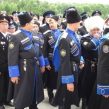
Cossacks Now Patrol Half of Stavropol Krai: Police Adjuncts or Something More?
Publication: Eurasia Daily Monitor Volume: 10 Issue: 159
By:

Cossack units are now patrolling the streets in 12 of the 26 districts of Stavropol krai as well as in Moscow and other Russian regions. Their presence suggests they are simultaneously, as they claim, adjuncts to the local police—street forces the authorities can deploy in extra-legal ways with deniability for themselves—and a cradle of possibly more serious challenges to regional leaders and to Moscow itself.
The first role of the Cossacks, that of adjuncts to the police, is especially prominent in Stavropol, a majority ethnic Russian region in the North Caucasus. There, Terek Cossack Ataman Aleksandr Fal’ko last week told Stavropol Governor Valery Zerenkov that 162 Cossacks are working full time, and 80 more part time, on patrolling the streets of 12 of the krai’s districts. In making his report, Fal’ko said that the Cossacks need government financing if this is to continue because they are performing a public security role (nazaccent.ru/content/8984-kazaki-rasskazali-gubernatoru-stavropolya-kak-patruliruyut.html). While some officials appear willing to help, others oppose doing so, apparently because they fear creating a force structure they will not be able to completely control (nazaccent.ru/content/8558-vlastyam-stavropolya-ne-nravyatsya-pretenzii-kazakov.html).
That the Cossacks could get out of hand or that they could be disowned as such even if they do what the authorities want calls attention to the second possible role that Cossacks in Russia may play. Last week, in neighboring Krasnodar krai, Cossack units forced Chinese and other migrant workers to leave by blocking their access to water that the guest workers were supposedly using illegally (bigcaucasus.com/events/actual/04-09-2013/86076-china-0/).
The actions of the Cossacks in this case crossed the line as far as Russian law is concerned, but the steps they took were apparently very popular among the local population. Such illegalities by Cossacks are a reminder that these units may take action at the behest of the authorities who do not want to take such steps on their own or—even more dangerously—take actions that reflect their own interests or those of other groups in the population against the authorities (bigcaucasus.com/events/actual/04-09-2013/86076-china-0/).
As a result of such developments, there is a danger and even the possibility that the Cossacks will demand more deference and financial support from the Russian authorities, writes Anton Bredikhin, a political scientist at the Russian State Humanitarian University (gumilev-center.ru/kazachijj-separatizm-sovremennoe-sostoyanie/). He further warns that these consequences may lead to the establishment of separate Cossack districts in areas where they have long lived, but which are defined as belonging either to Russians or non-Russian groups, or even the formation of an independent Cossack state on the basis of secession from Russia or Ukraine.
The scholar says that his goal is to “consider contemporary separatist and autonomous tendencies on the territory of Russia in regions that have an autochthonous [indigenous] Cossack population and also to analyze their prospects” and to assess how realistic they are. After a brief discussion of Cossack autonomist ideas during the Russian Civil War, Bredikhin notes that in the fall of 1991, as the Soviet Union was disintegrating, there were proclaimed several Cossack “state formations”: the Don Cossack Republic, the Terek Cossack Republic, the Armavir Cossack Republic, the Upper Kuban Republic, the Zelenchuk-Urupsk Cossack Soviet Socialist Republic and the Batalpashin Cossack Republic. These came together to form a Union of Cossack Republics of the South of Russia.
In December 1991, Cossack groups, together with a part of the Krasnodar Soviet Army garrison even tried to take power. They failed, and these various secessionist “republics” were suppressed by “local regional elites, not by the weakening federal center.” But if the republics are gone and if Russian realities have changed, Cossack interest in autonomy, either genuine or as a tactic to extract resources from the Russian authorities, has continued, Bredikhin says.
Some Cossacks, he notes, still talk about self-determination and secession, with a few even saying that they plan to appeal to the United Nations. But most Cossacks, the scholar continues, support the Russian state and its efforts to establish and maintain order. That does not mean their agendas are not a problem, however. Cossacks overwhelmingly support “the maximum integration of Russia, Ukraine, Belarus and Kazakhstan,” he says—a Russian policy, but one that at least some Cossacks see as a step toward achieving their own desire for more funding and more autonomy.
A possible reason for concern, Bredikhin admits, is that the younger generation of Cossacks is very different from its predecessors. Unlike them, it is ambitious, media saavy, and is “attempting to reanimate separatist ideas and, by using them, receive necessary preferences.” He does not discuss how these young Cossacks might behave if they make demands but are rejected. But “in the current political situation,” such demands are “not only impossible but unrealizable in the near term.” Just how long “the near term” will last, however, is not a question the researcher addresses.




